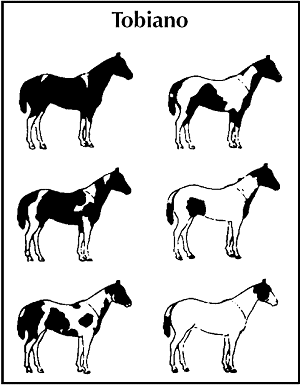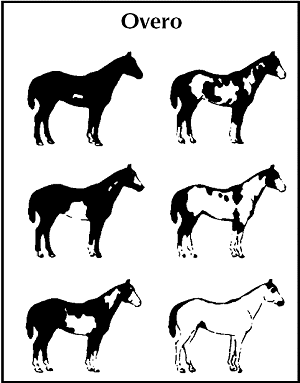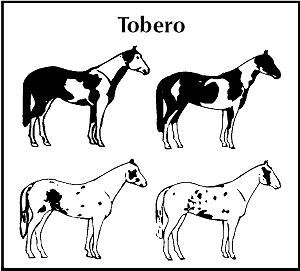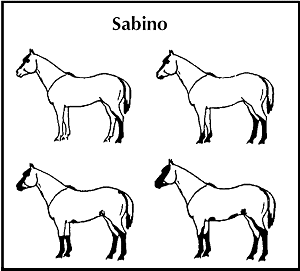Tobiano
(pronounced: tow be yah' no)
The head will usually be marked like a solid-coloured horse, either being solid or having a blaze, stripe, race or star and snip.
All four legs may be white, at least below the hocks and knees. Body markings will usually be regular and distinct, often being oval or round patterns that extend down over the neck and chest giving the appearance of a shield. The Tobiano Paint will usually have the dark colour in one or both flanks. The Tobiano may either be predominantly dark or white.
Unlike the Overo gene, a horse carrying the Tobiano gene will always display some Tobiano characteristics. There is a test avilable to identify the Tobiano gene (T), which is normally used to test for homozygosity. This is a recognised phenotype with the PHAA
A TOBIANO MUST ALWAYS HAVE AT LEAST ONE TOBIANO PARENT. TOBIANO IS A DOMINANT GENE.

Overo
(pronounced: oh vair" oh)
The head markings on the Overo are usually a blaze or bald face. The true Overo will usually have four dark legs and the white markings on the body or neck will appear to be framed by the contrasting coat.
As a general rule, the white markings will not cross the back between the withers and the tail. The tail will normally be one colour. The Overo paint may be either predominately dark or white. Blue eyes may be encountered in the Overo colour pattern, more than the Tobiano or Sabino patterns. The breeding of Overo to Overo may produce lethal white foals. More information on this is available from the Association.
It is possible for a horse carrying the overo gene to have next to no white anywhere on its body and be registered as 'solid'. Additionally horses showing the Overo phenotype may not carry the gene. There is a test available to identify the Overo gene (OLW). This is a phenotype recognised by the PHAA
AN OVERO MUST ALWAYS HAVE AT LEAST ONE OVERO PARENT.
IMPORTANT NOTE: As stated on the APHA web site, "In the United States, overo is usually used to mean "Paint, but not tobiano." This has resulted in the lumping together of three different spotting patterns under one name, and the result can be confusion in breeding programs."
In Australia we only use the term Overo to refer to the phenotype produced by the OLWS gene. The other colour patterns (but not phenotypes) of 'Sabino' and 'Splashed White' are referred to individally in Australia and are NOT referred to as 'overo' as in the US.

Tobero
(pronounced: tow bair' oh)
The Board of Directors has agreed that the progeny of a registered Tobiano and a registered Overo, that displays both colour patterns, is to be known as a "Tobero", and will be recorded as such on its Registration Papers and in the PHAA Stud Book.
By breeding Overo and Tobiano you could get a Tobiano, an Overo, a Solid, or a combination Tobiano-Overo called 'Tobero'. A Tobero has the genetic potential to produce either a Tobiano, an Overo or a Tobero from a Solid coloured partner.
One characteristic of Toberos, can be for the horse to appear to have a completely different coat pattern on either side of its body - tobiano one side and overo on the other.
A Tobero horse is a combination of Tobiano and Overo patterns only. There is a test available for both the Overo and Tobiano genes. This is a phenotype recognised by the PHAA.

Sabino
(pronounced: sa bee no)
The head markings of a Sabino can be a blaze, bald or apron face. These markings can be quite irregular and can appear to have slipped to one or both sides of the face.
White markings are common on the bottom lip and at times extend up the jaw. One or up to all four legs will have white markings that come to an upward shaped point, and quite often the Sabino will have a high stocking. These stockings can extend up as far as the elbow or stifle.
The Sabino may at times have markings appearing from under the horses belly. It may have white flecking through its coat and the edges of its white markings may be speckled or broken.
The Sabino colour pattern can crop-out of the purest bloodlines as many Quarter Horses carry these markings. In Quarter Horses, when the markings extend past the top of the knee and hock joint and beyond the corner of the eye and mouth including the bottom lip, the horse becomes eligible for the the Paint Horse Registry. Many other breeds such as Thoroughbreds, Arabians, Welsh ponies and Clydesdale and Shire horses also display sabino markings.
Genetic research has suggested there are numerous genes responsible for the Sabino pattern. These have now been named White (W) sometimes referred to as Dominant White. A test is available for the Sabino 1 gene (Sb1). This is a coat pattern, and not a phenotype recognised by the PHAA.

Splashed White
Splashed White is a much more common pattern than previously realised. Recent genetic advances have identified three Splashed White genes although there are believed to be at least two or three more yet to be found. It is usually characterised by a white 'dipped' muzzle and long stockings above the knees especially on the front legs.
In its minimum expression, there can be little or no white, alternatively a star and a snip and white socks. Its maximum expression is the classic belly splashes and white legs up to the body of the horse. One description of this trait is as if the horse has walked through a pool of white paint. The topline of the horse is usually a solid colour.
Blue eyes are also a characteristic of Splashed White horses. Deafness may be associated with some forms of splashed white. It is also commonly found in combination with Overo and occasionally with Tobiano where the genes can work together often enhancing each other.
A gene test is available for three of the Splashed white variants - SW1, SW2 and SW3. Like Sabino, there are at least two more SW variants for which cannot yet be tested. This is a coat pattern, not a recognised phenotype by the PHAA.


